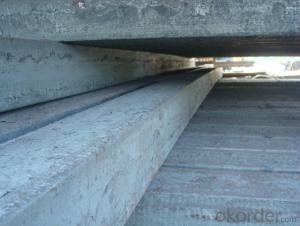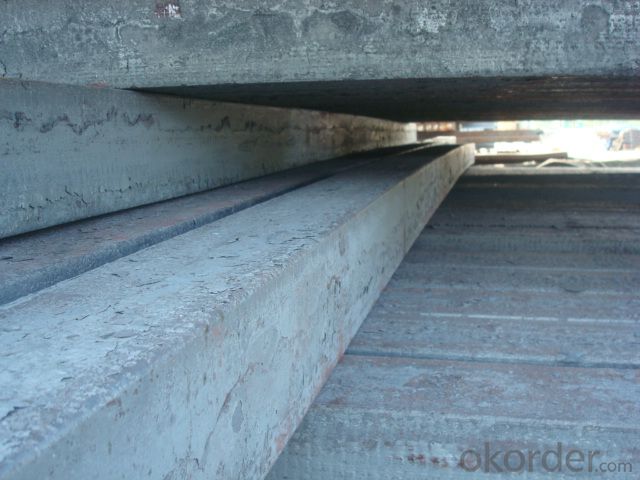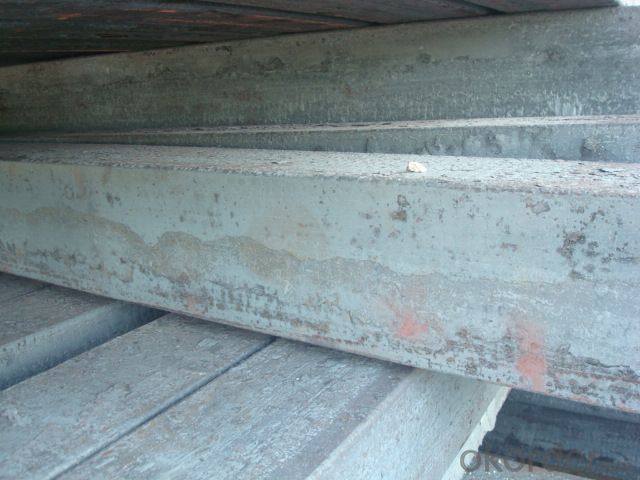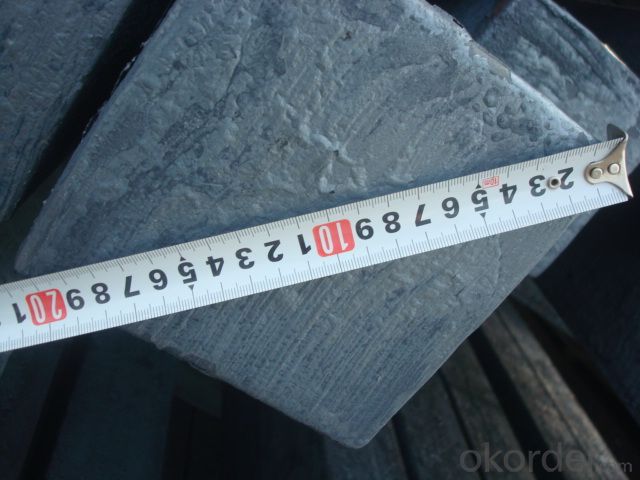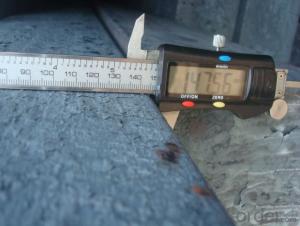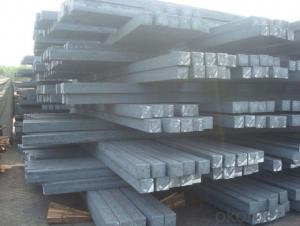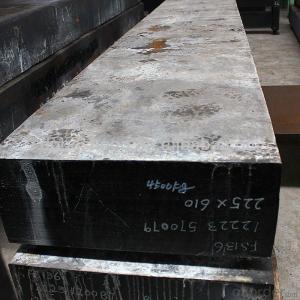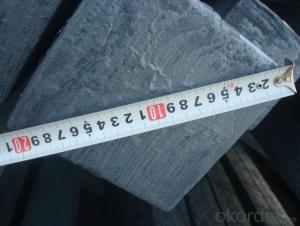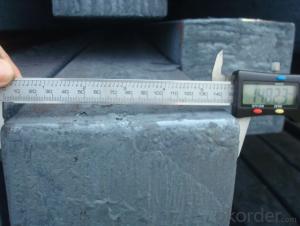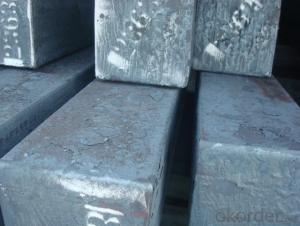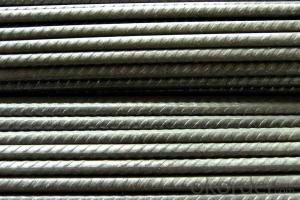Continuous Casting Steel Billet Q275 in Amazing Price
- Loading Port:
- Tianjin
- Payment Terms:
- TT OR LC
- Min Order Qty:
- 1000 m.t.
- Supply Capability:
- 200000 m.t./month
OKorder Service Pledge
OKorder Financial Service
You Might Also Like
STEEL BILLET
1.Structure of Steel Billet
Steel billet(ingot) by cogging or breakdown of semi-finished products, is the raw material of all kinds of steel mill. Billet section of square, round, flat, rectangular and abnormity of several kinds of, mainly related to the shape of rolled products.
2.Main Features of Steel Billet
Rectangular billet continuous casting billet and mainly general carbon steel, low carbon low silicon cold-rolled material, high quality carbon structural steel, high strength low alloy steel, special steel, etc.
The billet is mainly divided into two kinds from the shape:
Slab: cross section width and height of the ratio of the larger, mainly used for rolling plate.
Billet: equal cross section width and height, or a huge difference, mainly used for rolling steel, wire rod. ,
Steel billets have distinct characteristics as compared with already furnished steel bars and products. Billets have a specific grain structure, which enables the metal to be processed more intricately. Steel billets are also known for their malleability and ductility, especially when exposed to varying temperatures during shaping and molding.
3.Processing of Steel Billet
Steel billets are considered fresh and raw, and they must undergo a series of manufacturing processes before they can be used for various purposes. Billets are made by means of freezing molten liquid, and are later exposed to extremely low temperatures in order to allow the metal to take shape and solidify in chemical structure. The temperature manipulates the metal's physical properties, and tones its strength and durability. The subsequent processes provide the metal's curved mold design so that it can fit the allotted space provided by other machines, which complete the finishing procedures.
4.Steel Billet Images
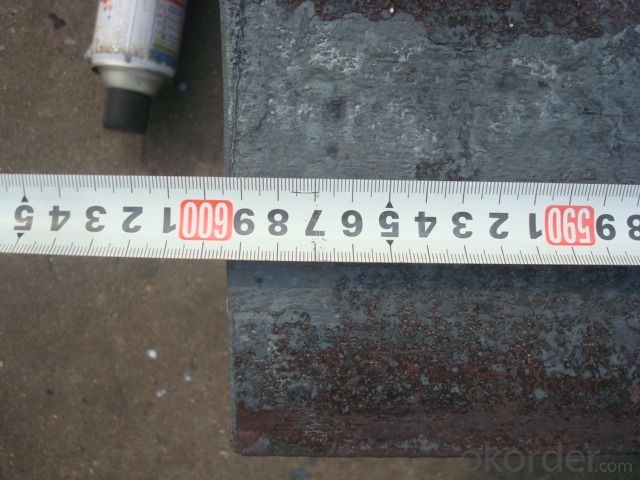
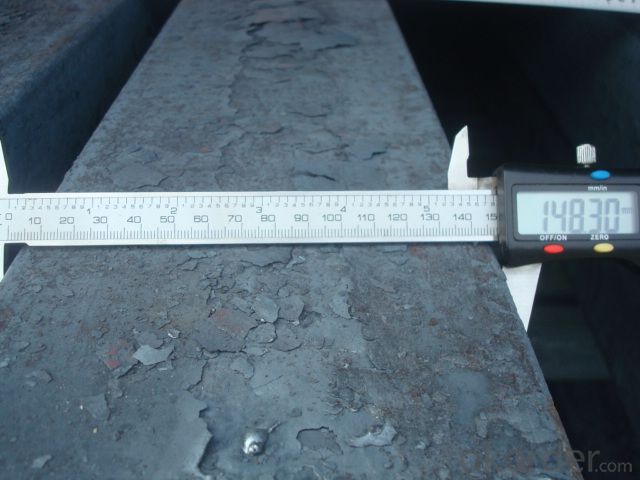
5.Usage of Steel Billet
Billets, or ingots (as they sometimes referred to), are not of practical use until they have been formed into more functional shapes and sizes. While they have already been put in the furnace, they still require a series of shaping and molding procedures such as hot and cold working, milling and cutting before they are sold in hardware stores, or used for different applications. The unformed billets, however, can be used in striking currency such as coins and as reserves, similar to gold bars.
6. Steel Billet Specification
Hot rolled billet steel
Size: 50x50mm-180x180mm
Steel Grade: 3SP, 5SP,Q195,Q235,Q255,Q275 Length:3m-12m
MOQ: 1000MT/size
Payment term: TT or LC
Packing: in bulk , bundle
Shipment: by container , bulk vessel
Packaging Details: bundles with steel strips or as customers's requirements
Delivery time: 15-30 days after the deposit
Loading port:Tianjin, or other port China
Origin :China
Inspection:Third party inspection before loading.
7.FAQ
We have organized several common questions for our clients,may help you sincerely:
1) How about your company?
A world class manufacturer & supplier of castings forging in carbon steel and alloy steel,is one of the large-scale professional investment casting production bases in China,consisting of both casting foundry forging and machining factory. Annually more than 8000 tons Precision casting and forging parts are exported to markets in Europe,America and Japan. OEM casting and forging service available according to customer’s requirements.
2) How to guarantee the quality of the products?
We have established the international advanced quality management system,every link from raw material to final product we have strict quality test;We resolutely put an end to unqualified products flowing into the market. At the same time, we will provide necessary follow-up service assurance.
3) How long can we receive the product after purchase?
In the purchase of product within three working days, We will arrange the factory delivery as soon as possible. The pecific time of receiving is related to the state and position of customers.Commonly 7 to 10 working days can be served.
4)Do you have your own QC department?
Yes, we have, our QC department will inspect the goods during the process of mass production and after completion of production.
5)If there’s something wrong with the quality of the products, how do we return the goods?
We promise you the quality will be the same as the samples you confirmed. If there’s something wrong with the quality of the products, please send back sample from the shipment goods to us and let us know the quantity, then we will investigate in our work shop. If it is our problem, we will offer you discount or replacements for free.
- Q: What are the common defects found in steel billets?
- Steel billets can exhibit various defects, both from the manufacturing process and external factors. One such defect is surface cracks, which can arise from inadequate cooling, handling, or excessive stress during rolling or forming. These cracks can weaken the billet and compromise its strength and integrity. Internal voids or inclusions are another common defect, caused by impurities or foreign particles in the steel. These voids create weak points in the billet, potentially leading to structural failures or diminished mechanical properties. Misalignment or misshaping is a defect that occurs during cooling or forming, resulting in uneven thickness or dimensions. This flaw adversely impacts the billet's performance and suitability for its intended application. Furthermore, excessive segregation of alloying elements can lead to uneven property distribution within the billet. This inconsistency hampers the mechanical properties and overall quality. Lastly, surface defects like scale, pitting, or imperfections can manifest due to improper handling, storage, or exposure to harsh environments. Though these defects may not affect the billet's structural integrity, they do impact the surface finish and aesthetics of the final product. To ensure the production of high-quality and reliable steel products, it is crucial to identify and address these common defects in steel billets. Regular inspections, quality control measures, and appropriate handling and storage techniques play vital roles in minimizing and preventing these defects.
- Q: How are steel billets used in the production of wind turbine towers?
- Wind turbine towers rely heavily on steel billets, which are essential semi-finished steel products. These billets serve as the primary raw material in the manufacturing process of wind turbine towers. To begin with, the selection of steel billets is conducted meticulously, taking into account specific properties such as strength, durability, and resistance to corrosion. These properties are crucial since wind turbine towers must endure strong winds, harsh weather conditions, and prolonged exposure to environmental elements. Once the suitable steel billets are chosen, a series of manufacturing processes are carried out. These processes typically involve heating, rolling, and shaping the billets into the desired form for wind turbine towers. The heating of the steel billets to elevated temperatures enhances their malleability and facilitates shaping. After the heating phase, the steel billets are rolled into elongated cylindrical shapes that closely resemble the final structure of the wind turbine tower. These rolled billets are then forged and welded together to create seamless tower sections. The welding process guarantees the tower's structural integrity and stability. Moreover, steel billets also find application in the construction of the tower's foundation. Large steel billets are deeply embedded into the ground, serving as a firm base for the tower. This anchoring method ensures the tower remains secure and prevents any potential movements or instability. In conclusion, steel billets are of utmost importance in the production of wind turbine towers due to their provision of the necessary strength and durability. Without steel billets, the construction of wind turbine towers capable of withstanding the demanding conditions they are exposed to would be nearly impossible.
- Q: How is the market for steel billets influenced by global economic trends?
- Global economic trends have a significant impact on the market for steel billets. Steel is a crucial raw material for industries like construction, automotive, and manufacturing, so any changes in the global economy can greatly affect the demand and pricing of steel billets. During periods of economic growth, there is typically an increased demand for steel products, including steel billets. This is because there are more construction projects and infrastructure development happening during these times. The demand is driven by increased consumer spending, urbanization, and government investments in infrastructure. Therefore, factors like GDP growth, industrial production, and construction activity are vital in determining the demand for steel billets. On the other hand, during economic downturns or recessions, the demand for steel billets tends to decrease. This is due to reduced consumer spending, fewer construction projects, and a slowdown in manufacturing. Global economic indicators, such as GDP contraction, industrial output decline, and reduced infrastructure investment, can negatively impact the market for steel billets. In addition to economic trends, global trade policies and tensions also influence the market for steel billets. Tariffs, quotas, and trade disputes between countries can disrupt the supply chain of steel billets, leading to price volatility and market uncertainty. Measures to protect domestic industries or restrictions on steel imports can limit the availability of steel billets in certain regions, affecting market dynamics and pricing. Currency exchange rates also play a role in the steel billet market. Fluctuations in currency values can affect the competitiveness of steel billet exports and imports. A strong domestic currency may make exports more expensive, reducing foreign demand for steel billets. Conversely, a weak currency may make imports more expensive, potentially increasing demand for domestically produced steel billets. In conclusion, the market for steel billets is closely tied to global economic trends. Economic growth, industrial production, construction activity, trade policies, and currency exchange rates all impact the demand, supply, and pricing of steel billets. Understanding and monitoring these global economic trends is essential for stakeholders in the steel industry to make informed decisions and navigate market fluctuations effectively.
- Q: Can steel billets be used for structural purposes?
- Yes, steel billets can be used for structural purposes. They are often further processed and shaped into various structural components such as beams, columns, and bars, which provide strength and stability to buildings, bridges, and other infrastructure.
- Q: How are steel billets used in the manufacturing of construction materials?
- Steel billets are used in the manufacturing of construction materials through a process called hot rolling. These billets are heated and then passed through a series of rollers to shape them into various forms such as bars, rods, or beams. These shaped steel products are then used in the construction industry to create structural frameworks, support systems, and other components required for buildings, bridges, and infrastructure projects.
- Q: How are steel billets used in the manufacturing of medical equipment?
- Steel billets are an essential raw material used in the manufacturing of medical equipment. These billets are semi-finished steel products that serve as a starting point for various manufacturing processes. In the medical equipment industry, steel billets are utilized to produce a wide range of components and devices that are crucial for healthcare professionals and patients. Firstly, steel billets are often transformed into stainless steel through a process called stainless steel casting. Stainless steel is highly desirable in medical equipment manufacturing due to its excellent corrosion resistance, durability, and hygienic properties. It is commonly used in the production of surgical instruments, such as scalpels, forceps, and scissors, as well as implantable devices like orthopedic implants, pacemakers, and stents. Furthermore, steel billets are also used to manufacture medical equipment components through precision machining. These billets are machined into various shapes and sizes, allowing the production of parts like connectors, valves, brackets, and frames for medical devices and equipment. Precision machining ensures that these components meet the strict quality and dimensional requirements necessary for medical applications. In addition, steel billets are employed in the production of medical equipment casings and enclosures. These components provide protection and support for sensitive internal components, ensuring the durability and longevity of medical devices. Steel billets are often used to create casings for devices like X-ray machines, CT scanners, and MRI machines, as well as smaller equipment like infusion pumps and monitors. Overall, steel billets play a vital role in the manufacturing of medical equipment by providing the necessary raw material for the production of components, casings, and instruments. The inherent properties of steel, such as strength, durability, and corrosion resistance, make it an ideal material for medical applications. The use of steel billets ensures the production of high-quality, reliable, and safe medical equipment that is essential for the healthcare industry.
- Q: What are the different surface treatments applied to stainless steel billets?
- There are several different surface treatments that can be applied to stainless steel billets to enhance their appearance and improve their corrosion resistance. Some of the most common surface treatments include: 1. Pickling: This process involves immersing the stainless steel billets in a bath of acid, such as nitric or hydrofluoric acid, to remove any scale or oxide layers that may have formed during the manufacturing process. Pickling helps to restore the stainless steel's original finish and provides a clean, smooth surface. 2. Passivation: Passivation is a chemical process that is used to enhance the corrosion resistance of stainless steel. It involves immersing the billets in an oxidizing solution, typically a nitric acid bath, to remove any embedded iron or other contaminants from the surface. Passivation forms a thin oxide layer on the surface of the stainless steel, which helps to prevent corrosion and maintain the material's integrity. 3. Electropolishing: This is an electrochemical process that is used to remove a thin layer of material from the surface of the stainless steel billets. By passing an electric current through the billets while they are immersed in an electrolyte solution, the surface is smoothed and any surface defects or impurities are removed. Electropolishing not only improves the appearance of the stainless steel, but also enhances its corrosion resistance and makes it easier to clean. 4. Grinding and polishing: These mechanical processes involve using abrasive materials to remove any imperfections or surface irregularities from the stainless steel billets. Grinding is typically done using a coarse abrasive wheel, while polishing uses progressively finer abrasives to achieve a smooth, reflective surface. Grinding and polishing can be used to achieve a variety of finishes, ranging from a brushed or satin finish to a mirror-like polished finish. These different surface treatments can be used individually or in combination to achieve the desired appearance and performance characteristics for stainless steel billets in various applications.
- Q: How are steel billets tested for quality?
- Steel billets are tested for quality through a series of rigorous procedures to ensure that they meet the required standards and specifications. These tests are crucial as they help determine the strength, composition, and other mechanical properties of the billets. One common method used to test steel billets is the ultrasonic testing (UT). This technique involves the use of high-frequency sound waves that are transmitted through the billet. The waves are then reflected back and detected by a receiver, which allows for the identification of any internal defects or inconsistencies in the material. Another important test is the hardness testing. This involves measuring the hardness of the billet's surface using various methods such as the Brinell, Rockwell, or Vickers hardness test. This helps assess the billet's resistance to indentation and provides an indication of its strength and durability. Chemical composition analysis is also crucial in determining the quality of steel billets. This is done by taking samples from the billet and subjecting them to a chemical analysis. By measuring the concentrations of different elements present in the steel, such as carbon, sulfur, and manganese, it is possible to verify if the billet meets the required composition standards. In addition, physical tests such as tensile testing are conducted to determine the mechanical properties of the steel billets. Tensile tests involve applying a controlled amount of force to the billet and measuring the resulting deformation or elongation. This helps assess the billet's strength, ductility, and other mechanical properties. Furthermore, visual inspection is an essential part of quality testing. Qualified inspectors carefully examine the billets for any surface defects, cracks, or irregularities that could affect their quality or performance. Overall, steel billets undergo a comprehensive range of testing procedures, including ultrasonic testing, hardness testing, chemical composition analysis, and physical tests, to ensure that they meet the required quality standards. These tests are crucial in verifying the strength, composition, and overall quality of the billets before they are used in various industrial applications.
- Q: How do steel billets contribute to the corrosion resistance of a product?
- The corrosion resistance of a product is not directly affected by steel billets. Instead, it is determined by the specific composition and treatment of the steel billets. Steel billets are essentially semi-finished steel products that act as raw materials for various downstream processes like forging, rolling, and extrusion, which ultimately produce the final product. To improve the corrosion resistance of a product, specific alloying elements and controlled processing techniques can be used during the manufacturing of steel billets. For example, stainless steel billets have a higher chromium content, which creates a protective oxide layer called chromium oxide on the steel's surface. This oxide layer acts as a barrier, preventing direct contact between the steel and corrosive environments, thus enhancing the corrosion resistance of the final product. Additionally, steel billets can undergo further treatments like heat treatment, surface coatings, or galvanization to enhance their corrosion resistance. Heat treatment processes like annealing, quenching, or tempering can modify the microstructure of steel billets, resulting in improved corrosion resistance properties. Surface coatings like paint, powder coating, or electroplating can provide an additional layer of protection, preventing direct exposure to corrosive substances. Galvanization involves coating steel billets with a layer of zinc, which acts as a sacrificial anode, corroding instead of the underlying steel to protect it. In conclusion, while steel billets themselves do not directly contribute to the corrosion resistance of a product, the composition, alloying elements, and treatments applied during their manufacturing process play a crucial role in enhancing the corrosion resistance of the final product.
- Q: How do steel billets contribute to the overall weight reduction of a product?
- Steel billets contribute to the overall weight reduction of a product through several key factors. Firstly, steel billets are formed through a process of hot rolling or continuous casting, which allows for precise control over the dimensions and shape of the final product. This enables manufacturers to produce steel billets with a high strength-to-weight ratio, meaning that they offer excellent structural integrity while being relatively lightweight. Additionally, steel billets can be further processed and shaped into various components of a product, such as sheets, plates, or bars. These components can be designed and optimized to have thinner cross-sections or hollow sections, reducing the weight without compromising the overall strength and performance of the product. This weight reduction is highly beneficial, especially in industries where lightweight materials are desirable, such as automotive, aerospace, or construction. Furthermore, steel billets can also be used in the production of advanced high-strength steels (AHSS) or ultra-high-strength steels (UHSS). These steels possess exceptional mechanical properties, including high tensile strength and improved formability, allowing manufacturers to use thinner gauges of steel without sacrificing durability. This, in turn, leads to a significant reduction in weight while maintaining the necessary structural integrity. In conclusion, steel billets contribute to the overall weight reduction of a product by providing a lightweight yet strong material for manufacturing. Their ability to be shaped into various components, combined with advancements in steel technology, allows for the production of lightweight products without compromising strength or performance.
Send your message to us
Continuous Casting Steel Billet Q275 in Amazing Price
- Loading Port:
- Tianjin
- Payment Terms:
- TT OR LC
- Min Order Qty:
- 1000 m.t.
- Supply Capability:
- 200000 m.t./month
OKorder Service Pledge
OKorder Financial Service
Similar products
Hot products
Hot Searches
Related keywords
